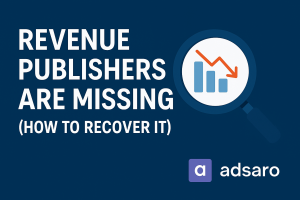In the fast-evolving world of digital advertising, Advanced Real-Time Bidding Strategies have emerged as a game-changer. They enable advertisers to purchase ad impressions in real-time through an automated auction process. But how does it work, and why is it essential for modern digital marketing? In this blog, we will explore the fundamentals of Real Time Bidding, its impact on your display advertising and many more. Let’s dive in.
What is Real-Time Bidding (RTB)?
Real-Time Bidding is a programmatic advertising method where ad impressions are bought and sold instantaneously through an auction-based system. When a user visits a website or an app that has Real-Time Bidding-enabled ad inventory, an auction is triggered within milliseconds. Multiple advertisers bid on the impression, and the highest bid wins, displaying their ad to the user.
How Does Advanced Real-Time Bidding Work?
Real-Time Bidding involve several key players:

Demand-Side Platform (DSP): Advertisers use DSPs to place bids and manage their campaigns. Amazon Ads, Criteo, etc.
Supply-Side Platform (SSP): Publishers use SSPs to make their ad inventory available for auction. Google Ad Manager, OpenX, etc.


Ad Exchange: This is the marketplace where SSPs and DSPs interact, facilitating real-time auctions. Google AdX, Pubmatic, etc.
Data Management Platform (DMP): Helps advertisers leverage data to target the right audience more effectively. Snowflake, Lotame, etc.


When a user loads a webpage, the following process occurs within milliseconds:

The website sends an ad request to the ad exchange.
The ad exchange communicates with multiple DSPs.


Each DSP evaluates the user data and submits a bid.
The highest bid wins, and the ad is displayed instantly.

Benefits of Advanced Real-Time Bidding Strategies
- Efficiency: Automated bidding reduces manual effort and optimizes ad spend.
- Precision Targeting: Advertisers can bid on impressions based on user behavior, demographics, and interests.
- Cost-Effective: Unlike traditional advertising, Advanced Real-Time Bidding Strategies ensure advertisers only pay for relevant impressions.
- Improved ROI: With real-time optimization, advertisers can adjust their bids based on performance.
- Better User Experience: Relevant ads improve user engagement and reduce ad fatigue.
Looking to implement Advanced Real-Time Bidding Strategies in your campaigns? Contact Adsaro for expert guidance.
Advanced Real-Time Bidding Strategies vs. Traditional Ad Buying
| Feature | Advanced Real-Time Bidding Strategies | Traditional Ad Buying |
|---|---|---|
| Process | Automated real-time auctions | Manual negotiations |
| Targeting | Highly data-driven | Limited targeting options |
| Speed | Instantaneous transactions | Time-consuming deals |
| Cost Control | Dynamic bidding adjustments | Fixed pricing |
Challenges of Real-Time Bidding
Despite its advantages, Real-Time Bidding come with challenges:
- Ad Fraud: Bots and fake traffic can inflate costs.
- Transparency Issues: Some advertisers struggle with visibility in the bidding process.
- Privacy Concerns: As data usage increases, compliance with regulations like GDPR is crucial. Read about GDPR compliance and its impact on programmatic advertising.
Future of Real-Time Bidding
With advancements in AI and machine learning, Real-Time Bidding are becoming more sophisticated. Emerging trends include:
- AI-Driven Bidding: More intelligent algorithms for better targeting.
- Cookieless Advertising: Privacy-focused solutions to comply with data regulations.
- CTV & Audio RTB: Expansion into connected TV and audio streaming platforms.
Lastly…
Real-Time Bidding are revolutionizing digital advertising by making ad placements faster, smarter, and more efficient. For advertisers looking to maximize their budget while ensuring relevant ad placements, Real-Time Bidding are an indispensable tool in their marketing strategy. As technology evolves, Advanced Real-Time Bidding Strategies will continue to shape the future of programmatic advertising. Want to stay ahead? Follow the latest trends on AdExchanger.








Leave a Reply